Kentucky Fried Zero – English Edition
This is the first part of our analysis of Kentucky Route Zero.
Original by Magnus Hildebrandt, translation by Dennis Kogel
Deutsche Versionen: Teil 1, Teil 2, Teil 3
English versions: part 1, part 2, part 3
Kentucky Route Zero, the Kickstarter funded adventure about a delivery driver searching for an unknown address in a surrealist Kentucky, is an exceptional game. It is filled with weird characters, strange sights and haunting symbolism. The free appendix episode “Limits and Demonstrations”, a fictional art exhibit with artworks corresponding directly to characters and events in the main storyline, shows that Kentucky Route Zero is even more layered and complex than it may seem at first glance. What is behind all this? Does it just mask missing substance with cryptic references?
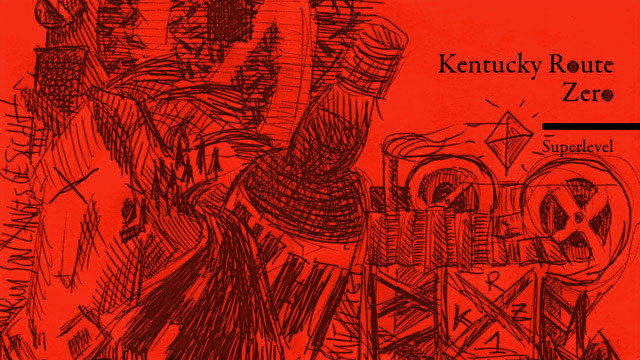
Since, so far, only episode 1 (of 5) has been released a definitive reading would be as reasonable as an analysis of “Twin Peaks“ after its pilot. But since episode 1 is chock-full with references it’s worth taking a closer look as developer Cardboard Computer (Balloon Diaspora, A House in California), comprising of Jake Elliott and Tamas Kemenczy, do not make use of sources typically found in video games such as comics, movies and other video games, but instead are inspired by the arts, theatre, poetry and local history.
Infinitely huge spoiler warning! Kentucky Route Zero works in huge parts because of its atmosphere and poetic narrative. In case you haven’t yet played episode 1; off you go to the Humble Store, and we’ll see each other in two hours. I’ll wait, I promise.
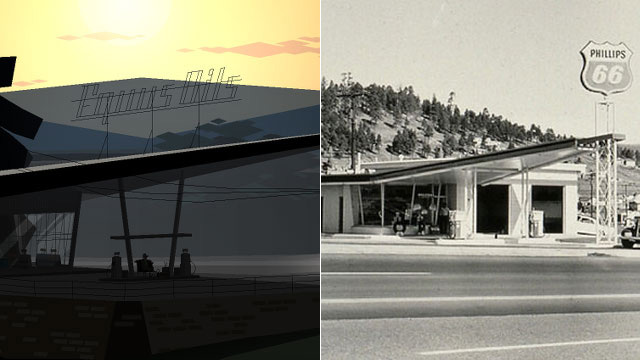
Economic crisis
Kentucky, the Bluegrass State is known for whiskey, horse racing, deep fried chicken bits and country music – those are the clichés we already encounter in the first screen of the game. But it’s not just about the booze! There is a far greater emphasis on the ongoing financial crisis and its impact on the people, which is, arguably, the main focus of the game. Surprisingly, Kentucky Route Zero doesn’t use “magical realist“ literature as a source material for this particular exploration, as the subtitle “a magic realist adventure game“ would suggest. References to the genre are limited to Gabriel García Márquez’s “One Hundred Years of Solitude” and are only surface deep, like the name Márquez or the address of the Márquez house.
Instead works of the Great Depression (1929–1941), especially by the writers of the “southern gothic” sub-genre, seem to be the main inspiration here. This literary genre features odd, partly grotesque characters, but never portrays them as caricatures — just like the people we meet in Kentucky Route Zero. Characters like the gas station attendant wouldn’t feel out of place in Carson McCullers “The Heart Is a Lonely Hunter“ or Flannery O’Connors “Wise Blood“. Elements like switching between playable characters during the dialogue sequences and the stream of consciousness narration suggests an influence of William Faulkner’s writing.
Another influence seems to be John Steinbecks “The Grapes of Wrath“. Although it is not part of the Southern Gothic genre, it is arguably the most important novel of the Great Depression. The Grapes of Wrath deals with an Oklahoma family that tries to escape from drought and hardship and is being torn apart by social and economic circumstances on their journey to the west. It’s also way better than Steinbeck’s “Of Mice and Men” which we all had to read at school.
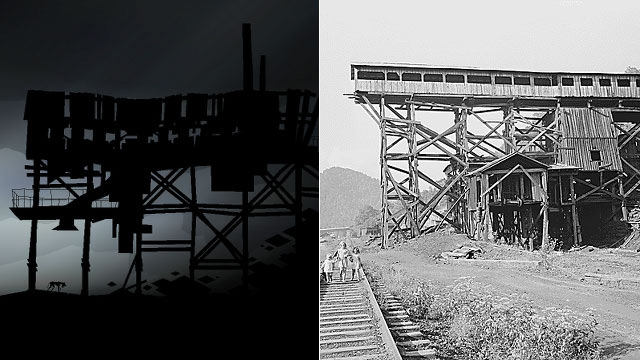
Besides Steinbeck’s novel, our image of that particular era is informed by the pictures of FSA-photographers. Under president Franklin D. Roosevelt, the “Farm Security Administration” (FSA) was a resettlement program in response to the economic crisis. Its goal was to establish a farming collective. Ultimately, it didn’t succeed and was disbanded by the succeeding government. Today this program is mainly known for its extensive photographic documentation. Best known among their photographers was Walker Evans, but it’s Russel Lee, who’s more of interest in the context of Kentucky Route Zero. For a health study, Lee took over 4000 photographs showing the living conditions of coal mine workers in Kentucky. His images were used as a visual reference for the Elkhorn Mine in the game.
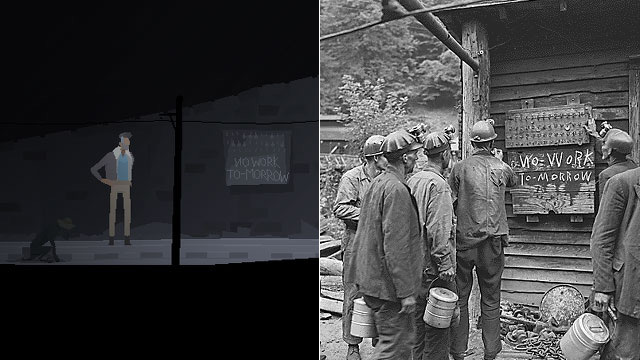
The stories surrounding this mine are based on real historical events like the ones found in Studds Terkel’s “Hard Times” and “Working”. Terkel was a passionate collector of oral histories and travelled across the USA to document the stories of the working class with his portable reel-to-reel recording machine. He aired these stories on his weekly radio show.
Among the many interviews Terkel has conducted over the years with people of all walks of life, known and complete nobodies alike, one with Alan Lomax was preserved for posterity in the book “And They All Sang”.
Lomax built up and managed the folk music collection of the Library of Congress and, like Trekel, he travelled across America. He collected field records of spirituals, Blues, Country and workers’ songs. We owe it to him that today there are recordings of Burl Ives, Woody Guthrie or Lead Belly, which would surely have been lost otherwise. The stories that deal with the music ethnologist we encounter in the game are clearly inspired by Lomax’ work. In Kentucky, Lomax recorded, among others, Aunt Molly Jackson, who at that time was engaged in the Harlan County War, a harsh and violent labor struggle for better working conditions. Those who want to find out more can watch the Academy Award winning documentary “Harlan County, USA (1976)“ directed by Barbara Kopple.
The last literary source I’d like to focus on here is the Robert Frost poem “The Death of the Hired Man“, which Carrington, a man we meet at the gas station, wants to perform as a theatre piece. It describes a farm helper named Silas (interestingly the name of a main character in Cardboard Computer’s “Balloon Diaspora”), who returns to work for his previous employers, a farming couple, in winter after leaving them after the harvest. Soon it becomes clear that he is too ill to work and has only returned to the farm to die in a familiar environment – which he, even before the couple decides to take him back in, does. The game has a couple of parallels between our protagonist Conway and Silas, as well as the dimly sketched Lysette and Ira and the farming couple.
Text-adventure
The second main topic of Kentucky Route Zero is the adventure game genre itself, which is referenced by the gas station attendant Joseph Wheatree. Joseph tells us that he and his friend Donald were electronic writers. Later we discover a software museum of sorts, filled with art projects and recent indie games from the likes of Anna Anthropy, Cactus or Telltale. Even this year’s IGF winner “Cart Life“ can be found here, as well as Josephs very own fictional game “If I Had My Way, I’d Tear the Building Down (1985)“.
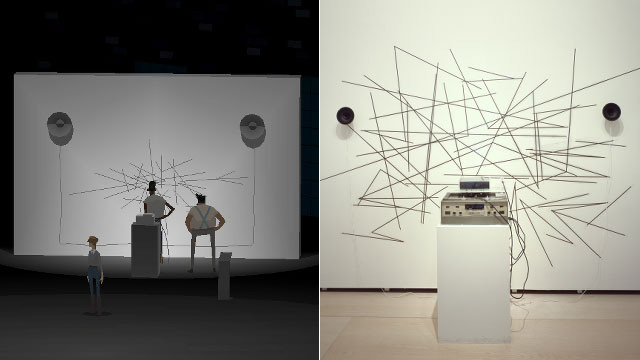
This is further explored in the Kentucky Route Zero stand-alone “Limits and Demonstrations“. In the virtual exhibition you find a work called “Overdubbed Nam June Paik installation, in the style of Edward Packer, 1965, 1973, 1980“. This is a reinterpretation of the art installation “Random Access” by video art pioneer Nam June Paik, in which the viewer composes a personal music piece by moving a sound pick-up across randomly arranged magnetic tape on the wall. The fictional installation is then combined with the concept of Edward Packer’s “Choose Your Own Adventure“ books, a precursor of the text-adventure, in which the reader makes decisions and gets referred tonew section in the book to find out about the consequences.
Parts of this interactive audio-play, featuring Joseph, Donald and the fictional artist of the exhibition Lula Chamberlain as its protagonists, are based on “Colossal Cave“ (also known as “Adventure“), the very first text-adventure. It was written in 1975 by engineer and hobby caver, William Crowther, In “Adventure” the player explores a virtual cave based on the Mammoth Cave in Kentucky.
In 2008, Kentucky Route Zero’s developers, then still calling themselves “The Guardians of the Tradition”, released a project called “Sidequest” for an art exhibit. It’s sort of a text adventure collage. In “Sidequest“ you are playing “Adventure” in the role of its creator William Crowther. You are in the game itself but simultaneously present at its creation. “Sidequest” intertwines locations like BBN Technologies, the Stanford Artificial Intelligence Laboratory, the Mammoth Cave and a polar station leading into the Hollow Earth . Caving and the Hollow Earth concept are also featured in a number of “Choose Your Own Adventure” books and are about the idea that the world features giant interior spaces, like the ones found in Jules Vernes’ “A Journey to the Center of the Earth”. For what we have heard so far about the eponymous Route Zero and its subterranean course, it is to be expected that these themes will emerge in later episodes.
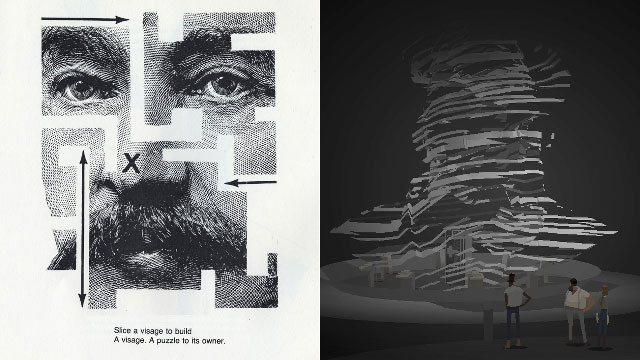
The name Lula Chamberlain, artist of the virtual exhibition “Limits and Demonstrations“, refers to William Chamberlain. In the 1980s he published the book “The Policeman’s Beard Is Half-Constructed“, which, allegedly, was written entirely by his computer program Racter on a Z-81 in BASIC. Another work in the exhibition called “Visage“ is a direct visualization of one of the books’ poems.
The Racter program was later bought by game company “Mindscape“ and released for home computers as a slightly mad version of ELIZA (1966) , which was one of the first computer programs with which you could “communicate“ in English language in a sort of psychotherapy session. Its creator Joseph Weizenbaum — the character Joseph Wheattree in the game is named after him as “Weizenbaum” is german for “Wheattree” — created the ELIZA session as a parody of real psychotherapy and was shocked when users started discussing their very real, private problems with the machine. Besides shocking and confusing Weizenbaum, ELIZA also had a big influence on the development of text-adventures, mainly on their parser, the part responsible for processing the entered text.
As little as we find out about Joseph’s former friend Donald so far, one could assume that he is based on Donald Michie, a leading British scientist in the field of artificial intelligence. Michie created one of the first self-learning computer programs, which could play “Tic-Tac-Toe“. He also programmed an artificial intelligence called Sophie based on infants’ learning process. During the 80s Weizenbaum and Michie were often engaged in public discussions, in which Weizenbaum advocated a more responsible handling of technological advances. For more on that topic, you should watch the 2010 documentary “Plug & Pray“. I should also mention that the Márquez cousins are named after scientists, too. In their case: the creators of communication theory Warren Weaver and Claude Elwood Shannon, with whom they also share some character traits.
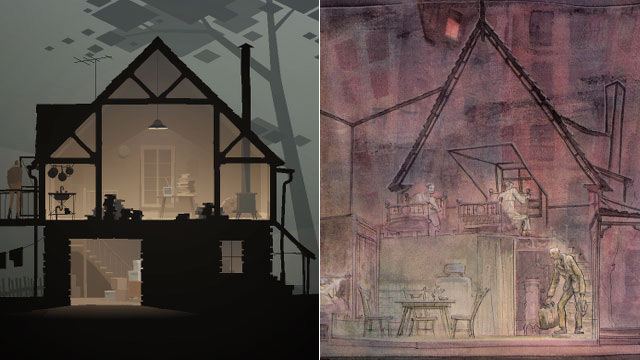
Theatre
Finally, some notes on the visual style of Kentucky Route Zero, which is mainly inspired by theatre set design. The design of the Márquez Farmhouse is to a large degree based on the two most well known productions of the Arthur Miller play “Death of a Salesman”, dealing with the collapse of an American businessman descending into madness. Influences on the game are to be found in the very theatrical movie version by Volker Schlöndorff, and in the original theatre production from 1949, for which the most influential American set designer Jo Mielziner developed its sets. Currently, a production, with meticulously reconstructed original sets, can be seen on Broadway. An important detail about Salesman’s set design is to be found in the production notes of the play. Here Arthur Miller states that the set is supposed to fluctuate between reality and dream and that the actors should behave differently depending on whether the scene plays out in the dream or in reality. In daydream sequences for example, actors can walk through walls. This technique is used in both versions of the play as well as in Kentucky Route Zero.
Another set designer that the developers name as inspiration, is Beowulf Boritt, which becomes most apparent in the interiors of the Elkhorn Mine.
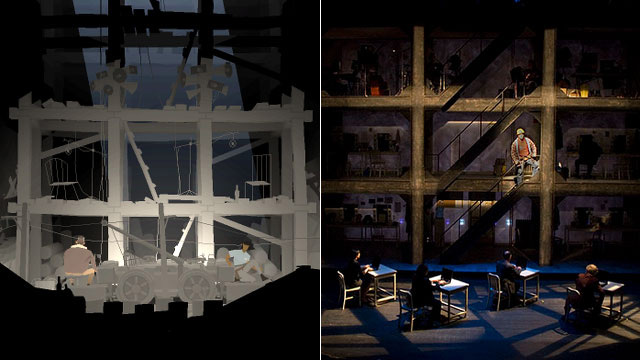
Global economic crisis, local history, American literature: The two hours of the first episode give you many interesting things to discover (and there is so much more). I cannot recall ever having played a game with such varied and coherently integrated cultural references. And on top of that it’s pretty as hell, naturally. At this point, how it all fits together, whether there is an underlying message and what the developers eventually try to achieve is still uncertain.
Episode 2 of Kentucky Route Zero will be released in April, the subsequent episodes every three months.
Guest author Magnus does not much care for Twitter or Facebook. If you need to get a hold of him, you can try the public bath in Schöneberg, Berlin, on a Wednesday.
Editing and additional writing by Benjamin Filitz, translation by Dennis Kogel.
Image sources:
Beowulf Borrit Design
Ed Rusha Gas Stations
Jo Mielziner Set Design
Smithsonian Museum
National Archives and Records Administration
UBUweb